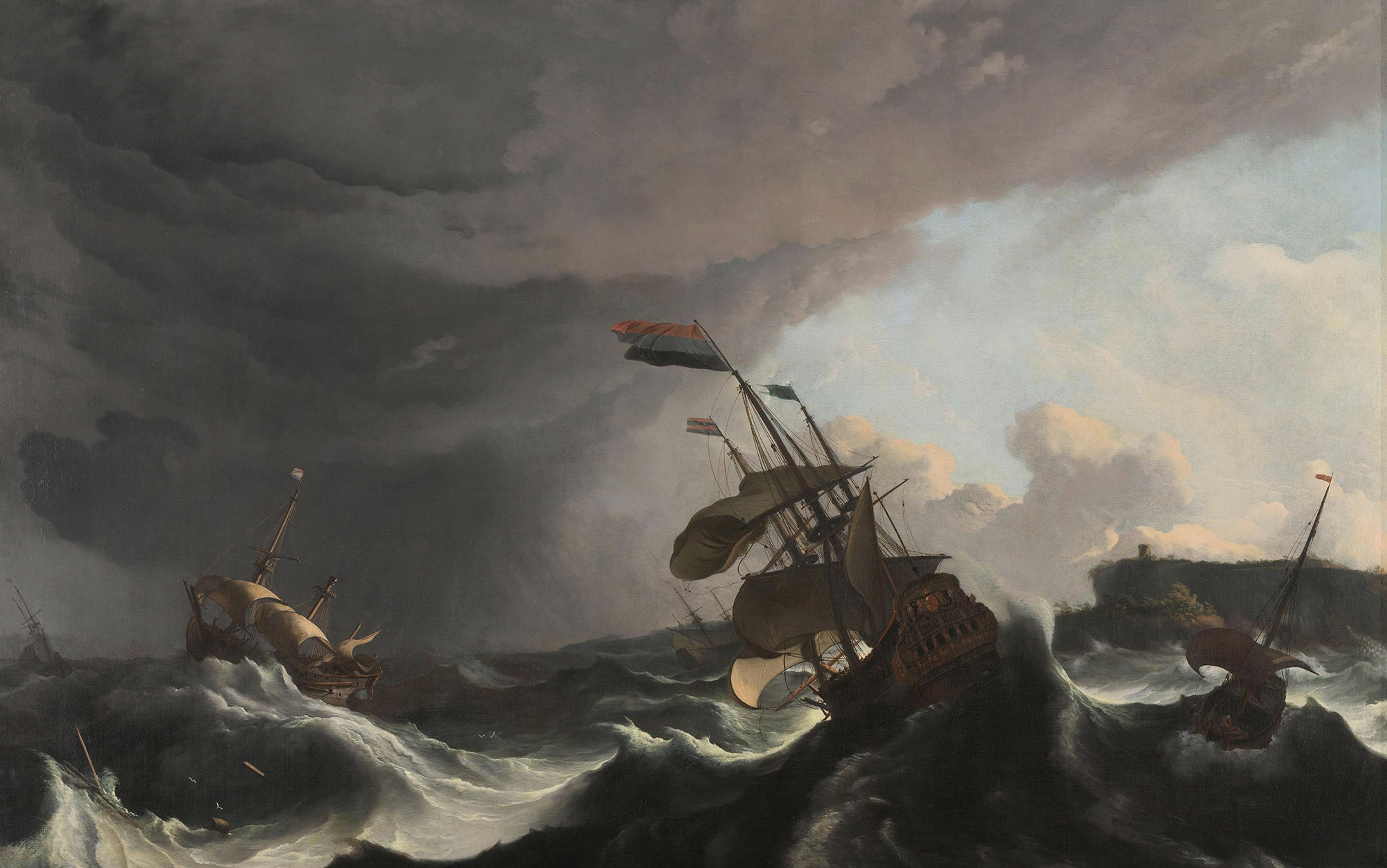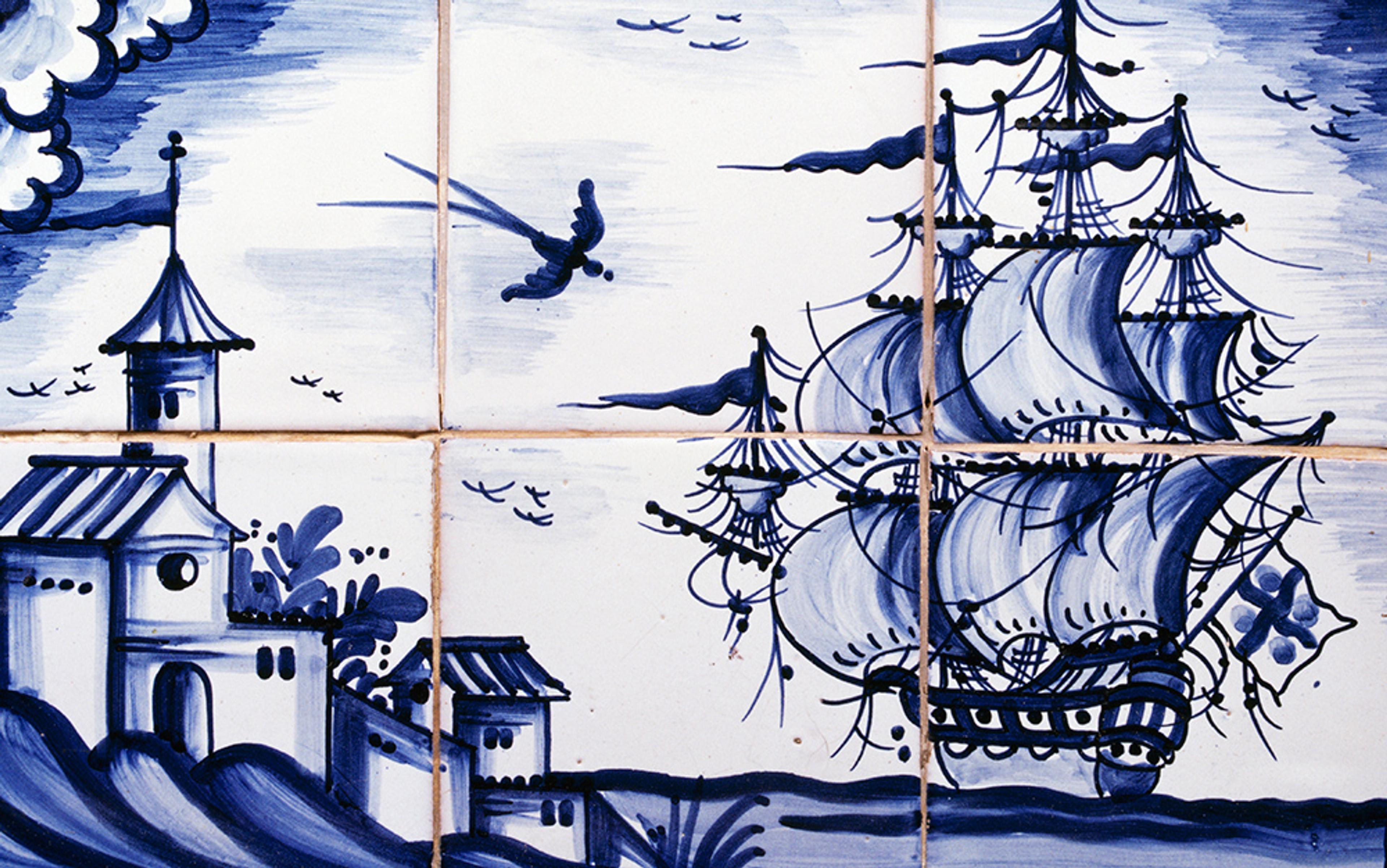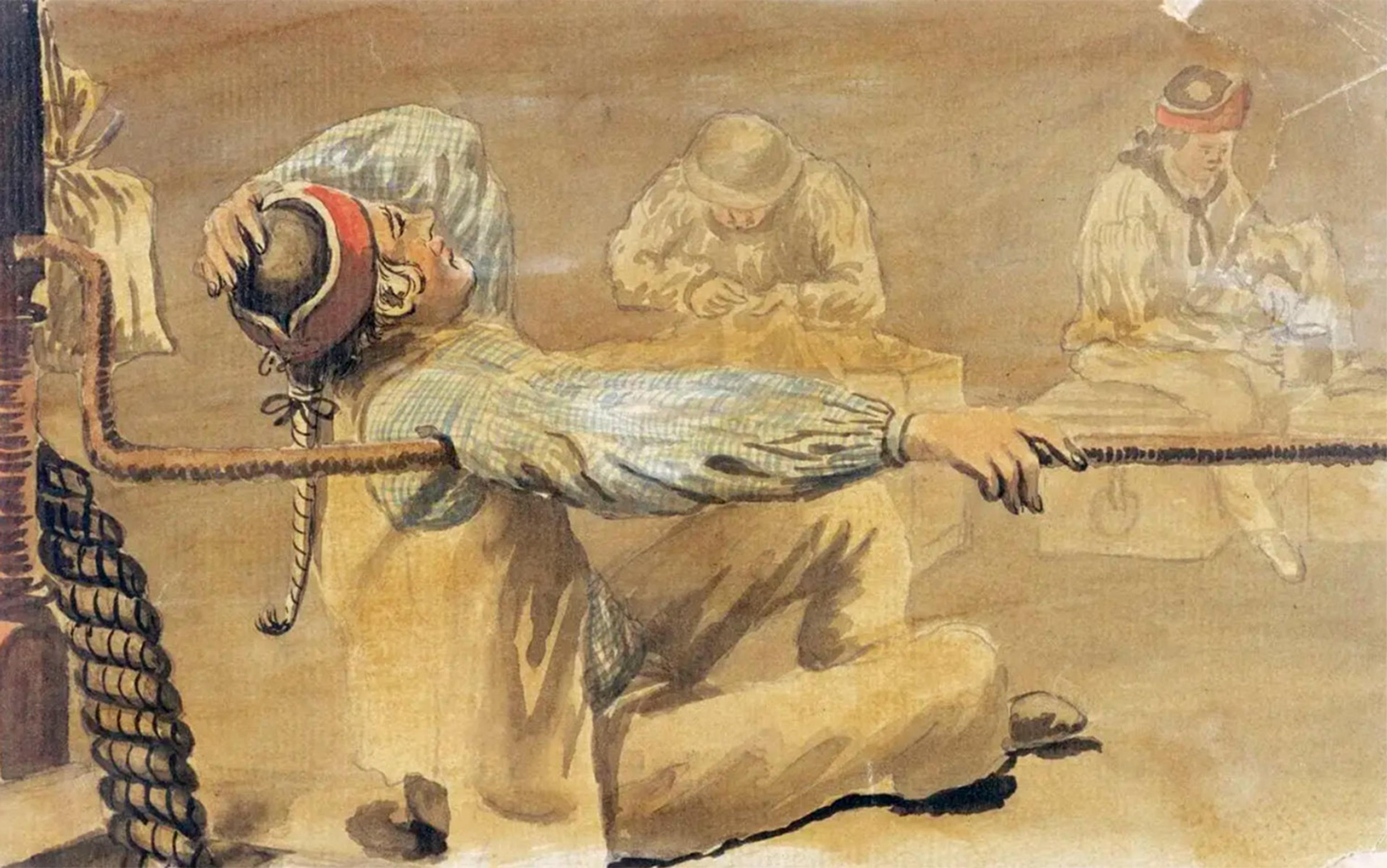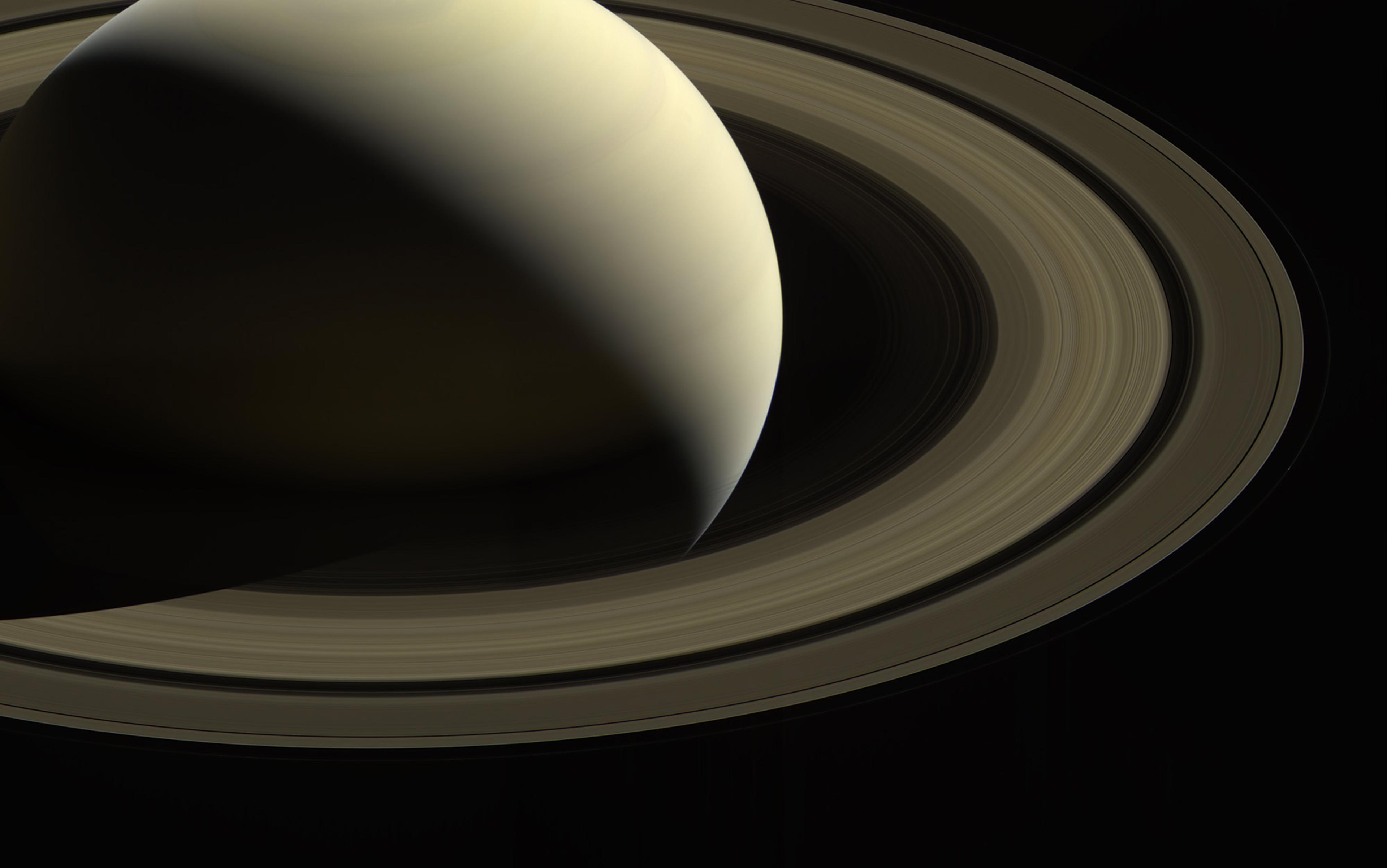In 1673, in a North Sea skirmish that killed nearly 150 men, the French privateer Jean-François Doublet took a bullet that tossed him from the forecastle and broke his arm in two places. How did the precocious young second lieutenant choose to spend his convalescence? Doublet repaired to the French port city of Dieppe, where he signed up for three months of navigation lessons.
This might seem a strange decision; Doublet, who had gone to sea at the age of seven, already knew the ins and outs of navigation. Why would he bother paying for lessons? The school in Dieppe – the Royal School of Hydrography – was renowned for the calibre of its lectures, attracting passing tourists as well as naval trainees. Doublet was keen to learn some more advanced techniques from the teacher, Abbé Guillaume Denys. In his memoir, Doublet explains a practical motive too: if he got injured again, he would retire and open his own sailing school.
Bold adventurers had a chance to enjoy considerable profits at sea in the early modern period (the 16th to 18th centuries) but they also risked their lives on every voyage. For Doublet, it was important to have a backup career plan. He never ended up teaching – he would spend the next three decades traversing the Atlantic and hobnobbing with famous admirals before, as a retirement project, writing his memoir. It might seem surprising that Doublet felt that teaching navigation was on a par with privateering, which was essentially legal piracy, with handsome prize money. Clearly, in the late-17th century, even knowledgeable sailors sought out more education. Records of these early schools are scarce – but Doublet’s detailed account of his time in Denys’s classes offers a rare glimpse into the technical education that early modern European sailors might have received.
During the 16th to 18th centuries, Europeans embarked on thousands of long-distance sea voyages around the world. These expeditions in the name of trade and colonisation had irreversible, often deadly, impacts on peoples around the globe. Heedless of those consequences, Europeans focused primarily on devising new techniques to make their voyages safer and faster. They could no longer sail along the coasts, taking their directional cues from prominent landmarks (as had been common in the preceding centuries). Nor did they have sophisticated knowledge of waves and currents, as did their counterparts in the Pacific. They had no choice but to figure out new methods of navigating across the open water. Instead of memorising the shoreline, they looked to the heavens, calculating time and position from the sun and the stars.
Celestial navigation was certainly feasible, but it required real technical skills as well as fairly advanced mathematics. Sailors needed to calculate the angle of a star’s elevation using a cross-staff or quadrant. They needed to track the direction of their ship’s course relative to magnetic north. Trigonometry and logarithms offered the best way to make these essential measurements: for these, a sailor needed to be adept at using dense numerical tables. All of a sudden, a navigator’s main skill wasn’t his memory – it was his mathematical ability.
To help the average sailor with these technical computations, maritime administrators and entrepreneurs opened schools in capital cities and port towns across Europe. Some were less formal arrangements, where small groups of men gathered in the teacher’s home, paying for a series of classes over the course of a winter when they were on shore.
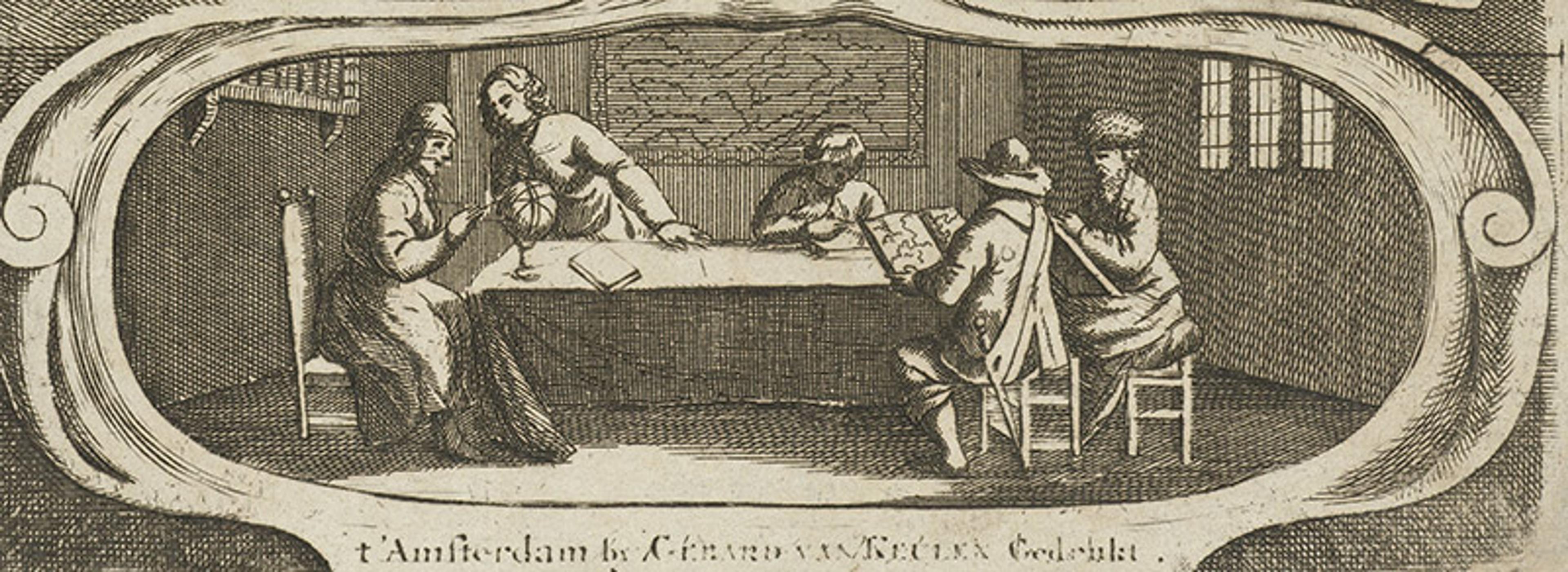
Illustration of a small Dutch classroom from The Golden Light of Navigation (1697), by C H Gietermaker. Courtesy Rijksmuseum, Amsterdam
In other instances, the crown set up official schools, usually footing the bill for young men who were expected to then serve in the nation’s navy. Many of these were modelled after the first official school, established by the Spanish crown in 1552 at the House of Trade (Casa de la Contratación) in Seville. It was counterintuitive to teach sailors in classrooms – most were barely literate – but educators chose to follow the pattern set by traditional universities: lectures, note-taking and formal examinations. Administrators devised ambitious, theory-heavy curricula, but they provided no instructions about how to teach this material.
In the 17th century, navies and trading companies began requiring their mariners to pass an examination if they wished to be promoted – to master, lieutenant, eventually even to captain. While sailors who were already competent navigators might not see the point of sitting through classes dedicated to theory, they were motivated by the prospect of upward career mobility. If you could read and had a head for numbers, you could climb the ladder quickly. A master or navigator (pilote in French, piloto in Spanish, stuurluy in Dutch) earned three times as much as an able seaman, and many would eventually secure commissions as captains. Sailors flocked to the classroom.
Sailors needed to learn the terms that would have been familiar to university students studying cosmography
The first schools in northwestern Europe popped up near the docks in Amsterdam, Le Havre and London. They were run by ambitious entrepreneurs who wore multiple hats: a number of them invented new instruments or wrote introductory textbooks, all of which they hoped to sell to their students. Some were mariners themselves, but most had virtually no experience at sea. Still, they harnessed the power of the printing press, and instruments galore, to help teach new mathematical concepts.
One teacher in Rotterdam, Jan van den Broucke, published a small textbook, Instruction about Navigation (1609). The humble volume was illustrated with the latest paper tools: tables, diagrams and moveable instruments. Van den Broucke offered keen sailors practical advice about how to get up to speed on astronomy. He reviewed basic definitions: what is a pole? Where is the equator? Sailors needed to learn the terms that would have been familiar to university students studying cosmography (the celestial parallel to geography). The Instruction included a list of 12 key concepts – from the signs of the zodiac to charts and compasses. Van den Broucke advised his readers to ‘hang the list over their bed [and] review it every evening for a year’. If they found such memorisation onerous, they could come take classes with him instead.
Van den Broucke taught readers and students a useful technique: how to use the Little Dipper to tell time. The handle of the dipper points at the North Star, and the bowl of the dipper rotates around it over the course of 24 hours. That means that when the two farthest ‘guard stars’ moved 15 degrees, one hour has passed. Once the constellation has rotated 90 degrees, six hours have passed. This functionality was so useful that most early textbooks included diagrams, often with volvelles, moveable discs that help the reader understand the concept.

A Volvelle (Dipper) from Instruction about Navigation (1609), by Jan van den Broucke. Courtesy Leiden University Library
Van den Broucke’s Instruction also offered a more elaborate tool for mastering the heavens: the ‘zodiac song’. To help students remember the stars, the song rendered all the constellations in 12 rhyming verses. In the northern hemisphere in March, for instance, you first see Andromeda’s belt rising in the sky, pursued by Cetus the Whale, followed by the ear of Aries the ram. These verses were set to the tunes of familiar hymns. Devout sailors could sing along, or so seemed to be the intention. It is doubtful, however, that many sailors learned the constellations through music. Claas Gietermaker, author of the immensely successful nautical manual Golden Light of Navigation (1660), included two different songs in the first edition of his Dutch textbook. But Gietermaker left the songs out of subsequent printings. He did retain two volvelles, suggesting that sailors found the hands-on spinning discs more useful than the verse and tunes.
By the time Gietermaker published the Golden Light of Navigation half a century after Van den Broucke’s Instruction, nautical manuals had evolved. The definitions that had been so important – pole and equator, zenith and meridian – had become common knowledge, and sailors now focused on a different set of essential skills: addition and subtraction, multiplication and division. The volumes burst with the newest tables and equations. Teachers took their students outside to make observations along the shoreline. Other classes piled into small boats so that they could sketch the coastline, training their eye for estimating distance as well as for cartography. At larger institutions, pupils might get to practise working the rigging of real or model ships. More often, a small group of men would gather around a table with a blank workbook, a set of drawing compasses and a globe. Teachers usually had all of this equipment available for purchase (and might even rent out a storage drawer for a small fee).
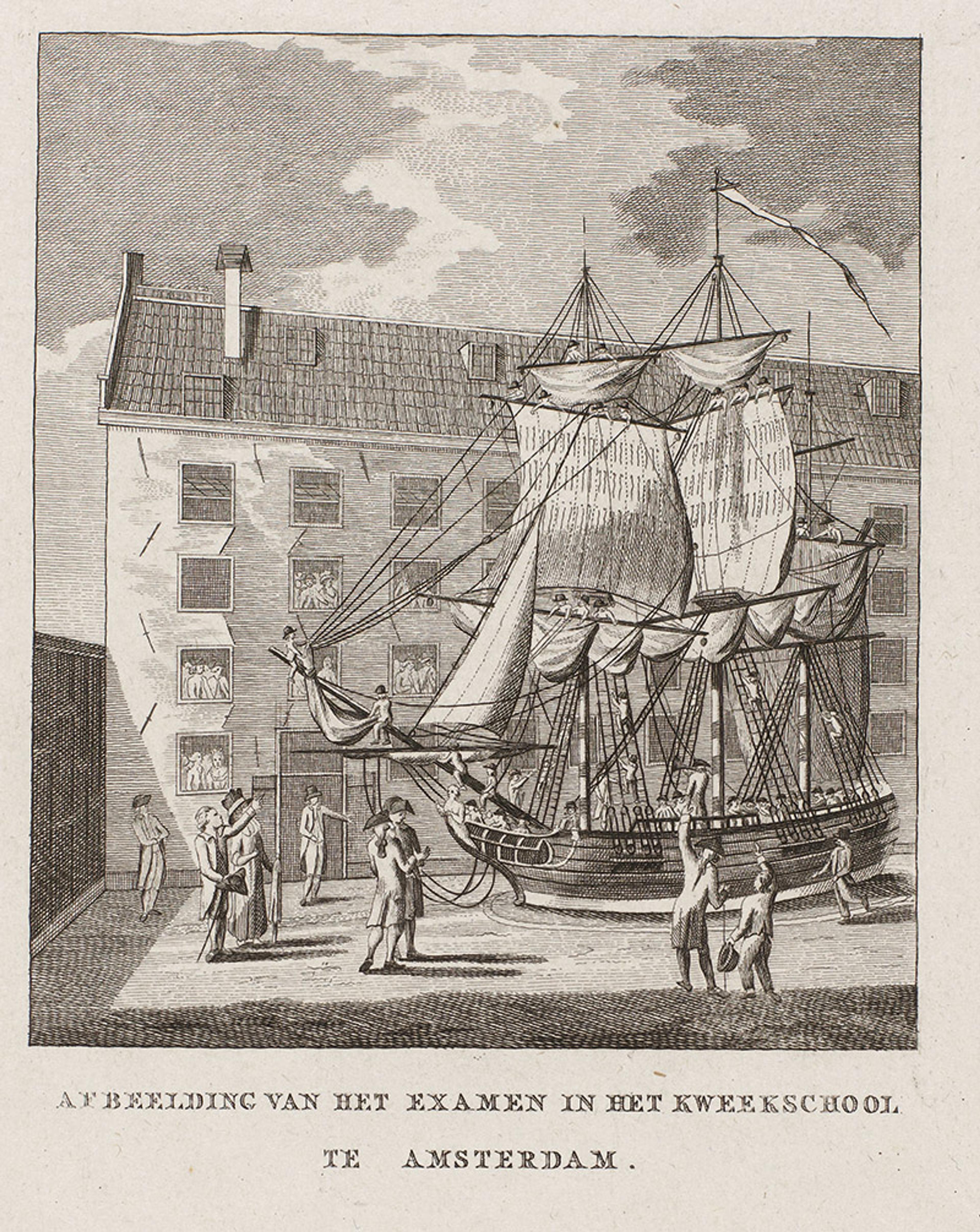
The Kaatje training ship in the courtyard of Amsterdam’s Seminary for Navigation. Courtesy Rijksmuseum
Classroom activities involved a fair amount of rote memorisation, and students were expected to copy out their teachers’ lectures verbatim. By the 18th century, teachers petitioned central administrators to ask that the students not waste time by copying out the textbooks – let them simply buy a copy!
Students owned manuscript workbooks where they copied out definitions of key concepts and answered questions. Some mariners spent more time on decorating their notebooks with calligraphy or doodles than on mathematics. But the manuscripts are invaluable: they let historians track which topics received the most attention, where students made the most mistakes, and what they did each day in class.
‘What course shall the man of warre shape to finde these pyrates?’
The most important textbook questions had to do with the boat’s course and position: ‘If your ship intends to sail west but is forced off-course by the wind … what is your true course and distance sailed?’ Straightforward trigonometry could give the answer. But sometimes a teacher would put more spin on the problem. Richard Norwood, in his Trigonometrie (1631), presented the following scenario:
A Merchant man … falls into the hands of pyrats; who amongst other things take away his sea-compasse. When he is gotten clear, he sailes away as directly as he can, and after two dayes meetes with a man of war [ie, a large naval vessel].
What is the next step? Naturally to hunt down the pirates! Since the merchant had ‘sailed since at least 64 leagues betweene the south and west, what course shall the man of warre shape to finde these pyrates?’ For more than a century, variants on this ‘pirate question’ appeared in textbooks.
There were also more idiosyncratic problems: one Dutch student carefully drew a trapezoid to answer a question about four old ladies sewing – how far apart were they from each other, and how many yards of cloth did each stitch? One common classroom exercise required students to trace out hypothetical routes for vessels as they zigzagged through a day’s sail. To make this interesting, teachers designed fantastic courses – castles, anchors, hearts – that students constructed in their notebooks, connect-the-dots style.
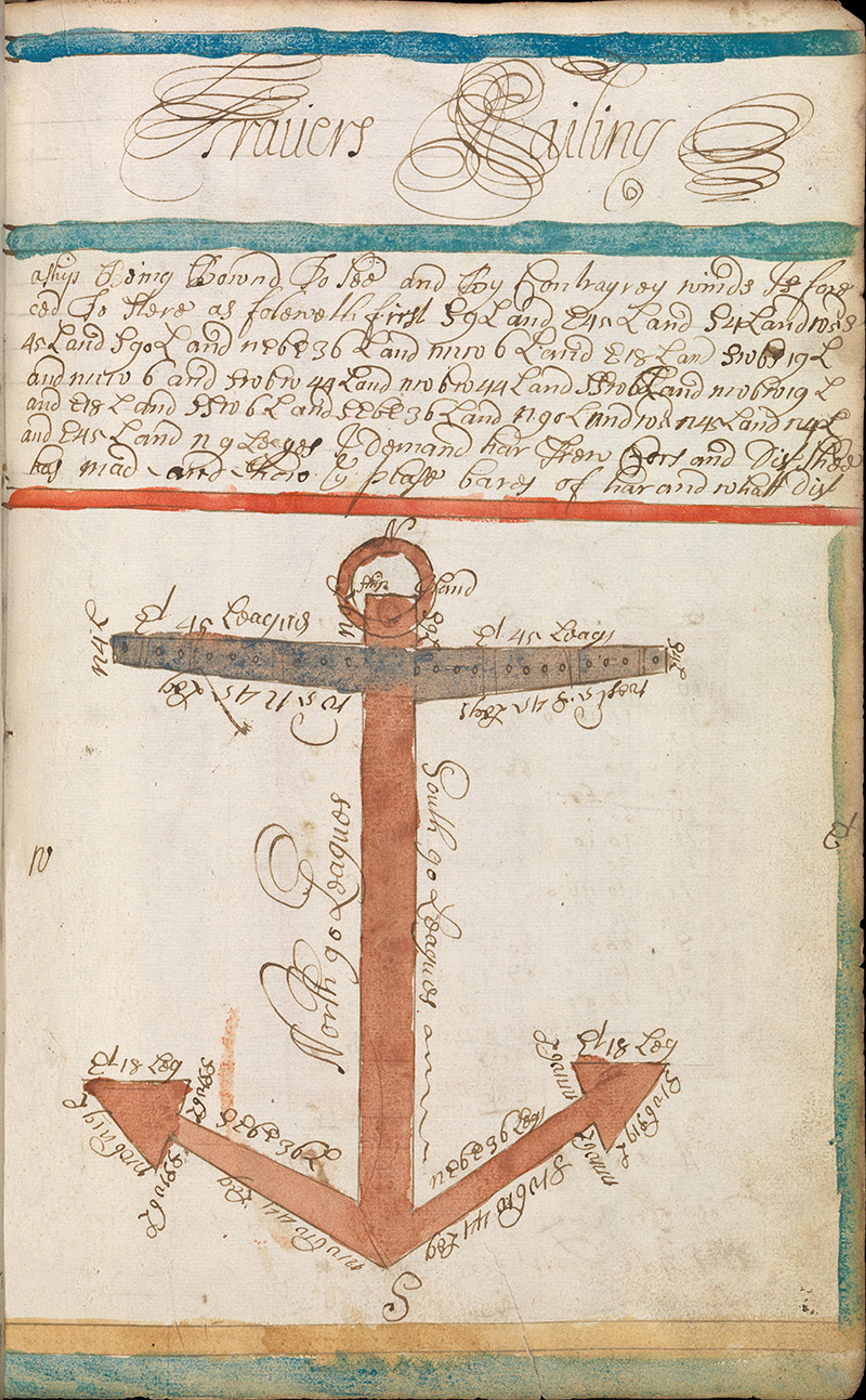
From the navigation workbook of William Spink RN (c1697-1731). Courtesy National Maritime Museum, Greenwich, London
Such questions aimed to make technical material as memorable as possible. Textbook publishers, for their part, did not want to dedicate costly paper to these sizeable diagrams – they appear almost exclusively in manuscript workbooks. Here again, the discrepancy between published book and student work tells us which parts of the extensive curricula were truly important. These classroom records reveal the theoretical material that sailors actually used at sea.
Thanks to the French privateer Doublet, we can get insight into the 17th-century ‘student experience’. We know from Denys’s own correspondence that he had been running a navigation school in his home since the 1650s. When Louis XIV’s main advisor Jean-Baptiste Colbert asked him to convert it to a royal college, Denys sunk money into renovations, for which he was never properly compensated. (Teachers, always underpaid, lodged many such complaints. They often supplemented their income with private tutoring on the side, but this could cause problems; their favourite students never failed the exams.) Denys’s school was on a noisy corner; he reported that it could be hard for the students to concentrate over the din of women selling their wares. Denys grumbled to Colbert about his feud with the merchant who sold the only magnets in town, obviously an important piece of equipment for mariners. Despite these issues, Denys’s hundreds of students evidently loved him, and he stood as godfather for several of their children.
Doublet tells us about Denys’s school itself. In 1673, he paid 50 livres a month for room, board, laundry and the necessary books. (These were almost certainly Denys’s own pioneering textbooks, which introduced trigonometry to French sailors.) Doublet notes that most students started with the basics – the tides, altitudes, and simple instruments such as Gunter’s scale and the sinical quadrant – but Doublet easily worked his way through spherical trigonometry and Euclid’s Elements. The young corsair turned out to be so proficient at the advanced mathematics of celestial navigation that Denys offered to foot the bill to keep him on in Dieppe as a teaching assistant. ‘You would oblige me infinitely by staying, for you would ease the puzzle of this [large] number of students, the majority of whom have heads as hard as stone.’
Denys made typical complaints about students. If some were bright and diligent, others stole school supplies or sold their textbooks for a profit. Absenteeism was a problem. French administrators experimented with paying senior naval officers to attend classes as role models – but that did not stop them from playing hooky. The navy then docked the wages of men who didn’t show up for class. At a Dutch school for officers in Batavia, the best student in class earned a sword.
Doublet needed no such coaxing. When his squadron leader ordered him back to sea after three months, Denys pushed back so that Doublet could stay in the classroom for three months more. Doublet was thrilled: he scored ‘six months of room and board for which I only paid three’.
After this stimulating scholarly interlude, the Franco-Dutch war (1672-78) continued to intensify so Doublet hurried back to sea to harry the enemy. But first, he did something that was increasingly obligatory for sailors: he took his navigator’s exam. (Denys covered the cost.) As was the custom, Doublet stood in front of a panel of ‘Four old captains and four pilots, who questioned me from all sides.’ The bright young corsair passed with flying colours. After a celebratory feast with Denys and his sister, Doublet finally headed back to his squadron.
Captain Dering, an overconfident young Brit, failed to correctly calculate the time of high tide at London Bridge
If Denys was unusually gifted at Euclidean geometry, many other average mariners followed him into the classroom to face the examiners. By the 18th century, sailors spent some portion of their training in a schoolroom. Navigation was no longer an art learned by apprenticeship – it was a science. Textbooks poured off the presses; sailors filled their workbooks with trigonometry. Although exams might not have been mandatory in every locale, mariners were keen to pass them. The Dutch author Gietermaker included a model exam paper in his Golden Light of Navigation. This simple two-page innovation made waves. Other authors quickly copied Gietermaker, and before long, most Dutch textbooks included a practice test.
Soon after this, mariners started cramming for exams. Instead of paying 36 florins for an entire winter of lessons, Amsterdam-based mariners paid just 6 florins for a crash course focused on the oral and written portions of the tests. Later manuscript workbooks confirm this strategy: students often focused on the questions they knew would be on their exam. Teachers at the close of the 17th century were already ‘teaching to the test’.
What were these exams like? Evidence is sparse, and Doublet is regrettably silent on his own experience. Admiralty records do preserve records of those who ran into difficulty: men who desperately wanted to earn their certificate, but repeatedly failed their examinations. Some flunked due to seemingly minor errors, while others persisted, and eventually earned their credential. For instance, Captain Dering, an overconfident young Brit who had ‘pretended to be a lieutenant after having been [on] one voyage to Wyborne’, failed to correctly calculate the time of high tide at London Bridge. This was one of the most straightforward and essential tasks – so he was summarily sent back to his ship, and told to reapply at a later date.
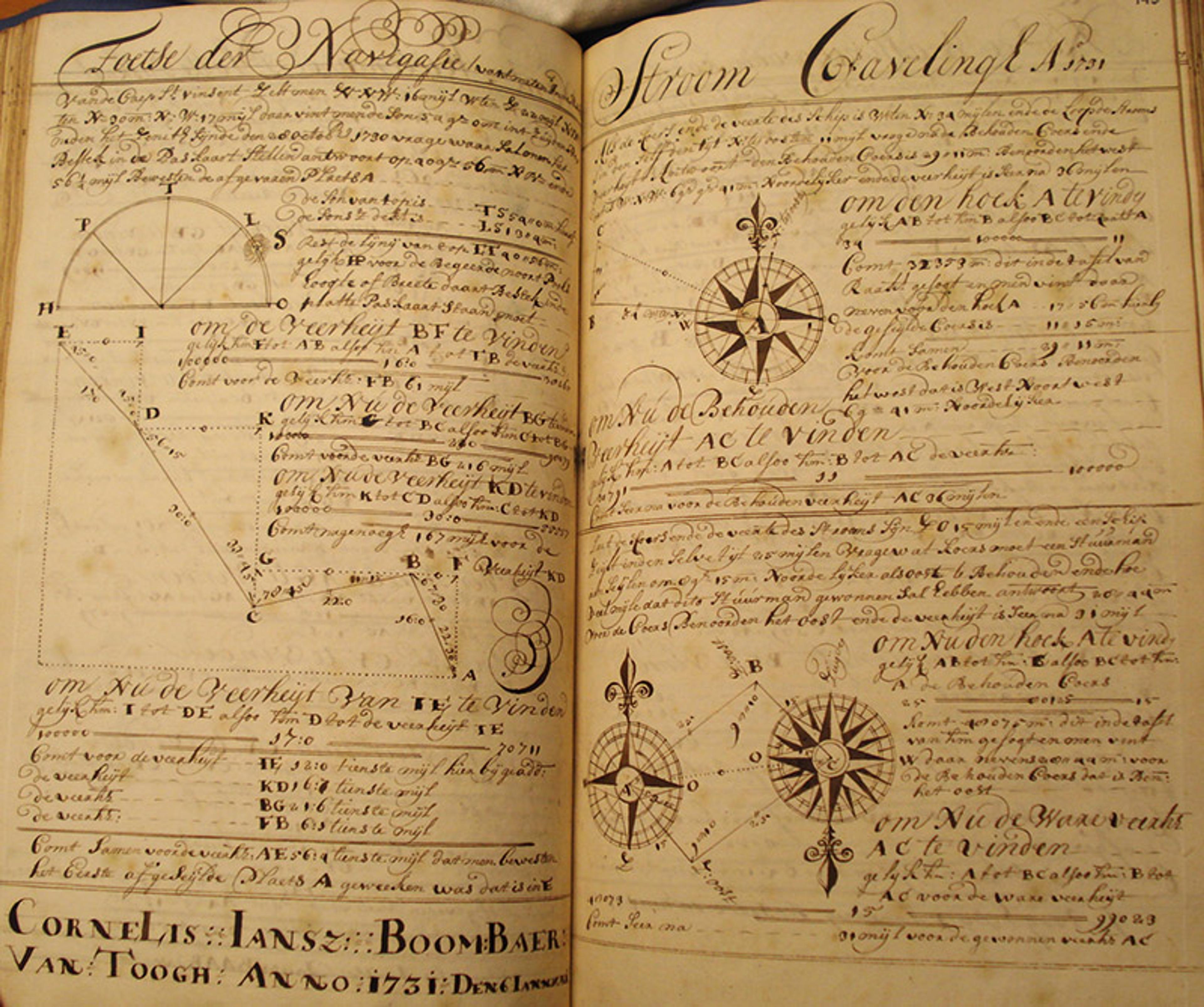
A practice exam in the navigation workbook of C. J. Boombaar (1727–32). Courtesy Het Scheepvaartmuseum, Amsterdam.
In the 1760s, a Dutchman, Frans van Ewijk, already held a position as a merchant captain. Unfortunately for him, the Dutch East India Company passed a rule making exams mandatory even for captains. In October 1768, Van Ewijk presented himself in Rotterdam for the exam – and promptly failed. He was deemed ‘very deficient in theory and practice’, and unqualified to serve as captain. He blamed his servants for distracting him with ‘much confusion and trouble’ at home, but the committee was not sympathetic. Undaunted, Van Ewijk showed up at an exam room in Amsterdam six weeks later. This time, he answered the questions satisfactorily. (Perhaps he had taken a crash course?) The following summer, Van Ewijk once again sailed as captain of a ship.
Another English candidate, Charles Hadsell, wished to get certified as a ship’s master in 1670. Just returned from the Caribbean, he had sailed for a decade with the notorious Captain Henry Morgan. In spite of more than 10 years at sea, he failed the master’s exam – twice! The panel of naval examiners found that ‘he could not give any Considerable answere to moderate questions in Navigation’. Even if he knew every cove and reef in the West Indies, they were clear: ‘We doubt of his Capacity in navigating a shipp on the greate Ocean.’ We cannot know if the Admiralty disliked Hadsell because he’d associated with the notorious pirate, but it seems clear: to please the examiners, he should have studied some practice questions. These mariners needed more than vessel-handling skills – definitions and theoretical concepts demonstrated your expertise to those around you.
In their quest for these credentials, maritime men sought out formal schooling. Pirates, privateers, merchants and navy hands did not just sail a boat from point A to point B; they needed to be able to track its position, to compute time and place. To do this, they needed mathematics.
Fortunately, in the 17th and 18th centuries, practical mathematics took off. For a reasonable fee, anyone who wished could acquire this bookish knowledge. Europeans felt the stakes were high, for their colonial fortunes rested on the shoulders of these navigators. In response, maritime educators developed an innovative hybrid form of training. Early modern navigation students memorised definitions and took notes but also got their hands on instruments, and answered many, many practice questions. Zodiac songs, creative diagrams, hands-on lessons along the beach – this combination of memory and mathematics caught the imagination of mariners, making it easier to grasp the technical skills needed on the high seas. Far from being drunken sailors, these men were clever mathematicians, using traditional approaches alongside the latest technologies to reach the far side of the globe.
